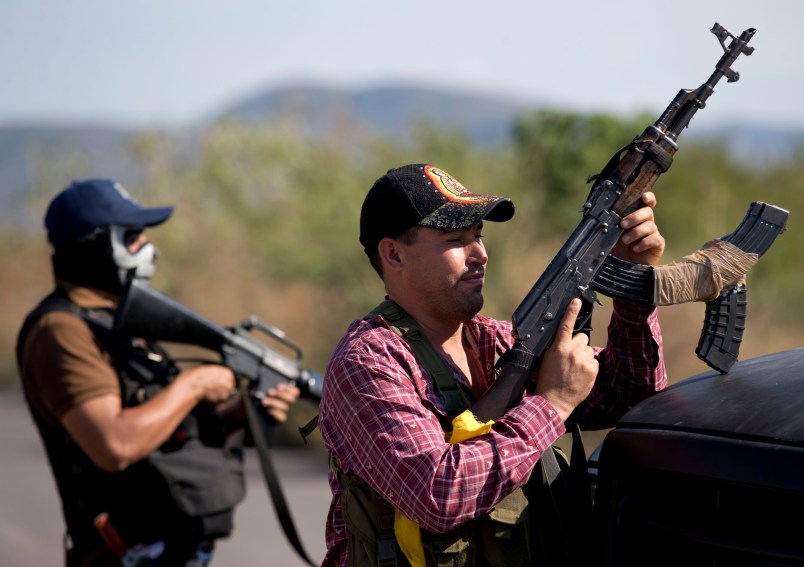MEXICO CITY (AP) — After months of tacit cooperation with rural vigilantes trying to drive out a cult-like drug cartel, the Mexican government is seeking to permanently solve one of its toughest security problems with a plan to legalize the growing movement and bring it under the army’s control.
But the risks are high.
To succeed, the government must enforce military discipline and instill respect for human rights and due process among more than 20,000 heavily armed civilians, then eventually disband them and send them back home in the western state of Michoacan.
In other Latin American countries, similar experiments have created state-backed militias that carried out widespread human rights abuses as armed civilians turned to vengeance, or assisted in mass killings. TheMexican army itself has been accused of rights abuses during the more than seven-year war against organized crime that has seen it deployed as a police force in much of the country.
Vigilante leaders met Tuesday with government officials to hash out details of the agreement that would put avocado and lime pickers with AR-15 semi-automatic rifles under army command. The Mexican military has a century-old tradition of mobilizing “rural defense corps” manned by peasants to fight bandits and uprisings in the countryside.
If the latest experiment works, it will resolve one of the thorniest dilemmas in the barely year-old administration of President Enrique Pena Nieto: how to handle a movement that sprang up outside the law but successfully took on a pseudo-religious drug cartel, the Knights Templar, which Mexican authorities had been unwilling or unable to take on for years.
Over the last year, the vigilantes, many of them former migrant workers who spent years in the United States, have seized a dozen towns terrorized by extortion, killings and rapes at the hands of the cartel’s gunmen. Members of the Knights Templar have tried to portray themselves as soldiers in a reincarnation of a medieval religious order dedicated to Christianity and the expulsion of abusive police from their communities.
In many instances, Associated Press reporters have witnessed federal forces stand on the sidelines while the “self-defense” forces routed the cartel, and occasionally even aid the vigilantes by conducting joint patrols and manning highway checkpoints together.
Mexican experts so far have widely accepted the administration’s plan announced late Monday, calling it a smart way to maintain the movement’s momentum against the Knights Templar while protecting the government against charges it was ceding the rule of law in the “hot lands” of Michoacan, a rugged Pacific Coast state of rich agricultural land and mountains studded by marijuana fields and methamphetamine labs.
But in other parts of Latin America, the news stirred traumatic memories.
Claudia Samayoa, a human rights activist in Guatemala, said the thousands of deaths attributed to the army-backed Peasant Self Defense Patrols during the country’s 1960-1996 civil war are too fresh to allow for more paramilitary forces in the region.
“The cure is going to be worse than the disease,” Samayoa said. “It would be better not to go down that road, and instead strengthen law enforcement and the justice and public safety systems.”
Margarita Solano, of the U.S. risk-analysis firm Southern Pulse, said Mexico’s vigilantes have awakened memories of her native Colombia’s experience with self-defense forces such as the “Convivir” movement that fought leftist rebels in the 1990s. While the groups were initially welcomed, some were later accused of rights abuses.
“I’m finding differences and certain similarities that are frightening,” Solano said.
Mexican authorities are portraying the legalization of the “self-defense” forces as a stop-gap measure. Unable to disarm the vigilantes because of the popular support they have for kicking the Knights Templar out of much of the state, federal officials will now have to work with them to clean up the rest of the gang — and then persuade the vigilantes to demobilize. The government has stressed the plan is temporary, and says vigilantes will have to register their guns.
With self-defense checkpoints on most major roads in Michoacan’s hot lands, and armed vigilantes often drinking beer or smoking marijuana at their posts, there are ample possibilities for abuses.
But many Mexicans are less concerned than outsiders about the potential for wrongdoing by the vigilantes. They note there are fundamental differences between Michoacan, where relatively prosperous farmers are funding the vigilantes to fight cartel extortions, and Guatemala, Colombia and Peru, where poor farmers were pressed by right-wing governments into fighting bitter wars against leftist rebels.
In the rich, flat lands of Michoacan, “there aren’t any leftist guerrillas or poor farmers,” said Raul Benitez, a security expert at Mexico’s National Autonomous University. “Here there are well-off farmers fighting criminals.”
Unlike the vigilante movement in the neighboring Mexico state of Guerrero, where “self-defense” forces are often anti-government, many of Michoacan’s vigilantes say they just want to get back the rich pasture and lime groves that the Knights Templar stole from them.
It is a mixed movement, in which upper middle-class orchard owners, ranchers and businessmen often pay farmworkers to help man -defense patrols and buy them guns. But the poor were also affected by the cartel’s extortions and abuses, and have often have reasons of their own to join the movement.
“The comparisons with Colombia, Peru or Guatemala are an aberration,” Benitez said. “Right now, the ‘self-defense’ forces need the respect of the local residents and public opinion, so I think they are not going to commit any crimes now.”
Copyright 2014 The Associated Press. All rights reserved. This material may not be published, broadcast, rewritten or redistributed.






